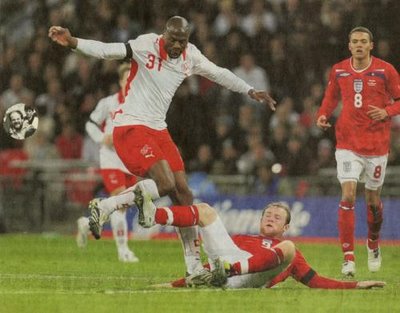Veronika Spierenburg
Wednesday, 27 May 2009
Work from Newspaper no. 5 and Newspaper no. 4.
“Veronika Spierenburg’s Newspapers series no. 4 + 5 are a playful dissection of spectacle as it exists in sports photography, not in an overly analytic way but as one disassembles a machine out of curiosity – to inspect and marvel at its parts. Spierenburg approaches this spectacle first by disregarding the conventional way of viewing a football game “I am not a football fan…I don’t understand the rules of football…(but)…I am fascinated by the aesthetics of the football photos.” So we are no longer dealing with the football game as such but rather the body of material that is produced in photographing the game. In real time, while the ball is “in play” one is scarcely able to see the football as anything other than a blurry, circular mass flying through the air. It is only through photography that an object such as a football appears as a stationary orb, holding its position in mid-air while men are frozen in heroic poses of exertion, of concentration upon the fate of the ball, all at close range, as if we were joining them on the playing field. As Spierenburg notes “the football is more than a football, it is a magnet of gazes” and as in the eye of a storm, all eyes are on the struggle over the object yet there is a blankness, a sameness, a silence to the presence of the football itself. It is as in films when, in a decisive moment, all goes quiet as we brace for the outcome- the football photos are all infused with this sense of a dramatic, expectant pause -which has been amplified by Spierenburg’s treatment of the source material.
In series no. 4, the space in each photograph which would be occupied by the football is eclipsed by black & white photographic images, each one incidentally taken from “Freiämter Kalender” – a yearly publication of regional statistics and information which covered Freiamt, Switzerland the home of the Artist’s mother during the 1970s-80s. Each year all of the people who had died in this district were briefly memorialized in the Kalender, three of these obituary photographs are inserted here as one might have fitted them into an amulet – small, anonymous black & white micro-local print media which contrasts with the large color-saturated spectacle which could be taking place in any major stadium in the world, and then published in any newspaper worldwide. In newspapers no. 4 the blankness/ silence of the ball spoken of above is denied by this image which covers it, expecting to find silence we find instead a deep space, a circular window (as in a submarine) into another time/space – Spierenburg says she chose black & white images so that they register within our brain “as a time shift”, with the result that this object which is at one moment here, another moment there, at all times in the center of action, is again far removed from the commotion taking place around it. An unexpected formulation of the political also arises in these tiny worlds (of the anonymous and the dead) that are caught up in a spectacular power struggle between giants, who seem incognizant that these spheres that they are kicking around even contain life within them. Both the players and the figures within the contours of the balls seem detached- utterly apart from and unaware of one another- this is of course through the semiotic play of montage where bringing disparate materials close together materially invokes spatial and psychological distance.
The Newspapers no.5 series similarly uses images of football coverage found in newspapers as its source material but is not based around the ball at all, but on a very spare slicing of the picture plane which effectively leaves the limbs of the players cropped, becoming disembodied- ghost limbs, in motion with no center of gravity, sometimes no head – still flailing around after the ball like a chicken with its head cut off. This is both a disruption and a magnification of certain aspects of the sports spectacle. The lack of a centre, a spine, or a head tends to accentuate the dynamic and often precarious movements of the football player – accelerated movement is often represented by a breakdown or fragmentation of parts, as in many Cubist works. Here it is as if in the ecstatic movement of the limbs they become independent and autonomous- a body in themselves, continuing with the game. In the background, the bleachers are in soft focus, an unformed, soft and colorful mass watches intently the crystalline, balletic movements of well-defined knees, shins, outstretched wrists, and aerodynamic sportswear. It is as if the fetishisation of the power of the player’s body has reduced the body through selective focus and abrupt cropping to these isolated appendages, angling motionlessly in their moment of power. ” – Noah Angell





